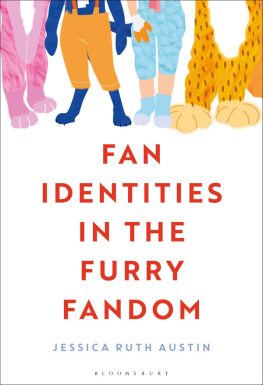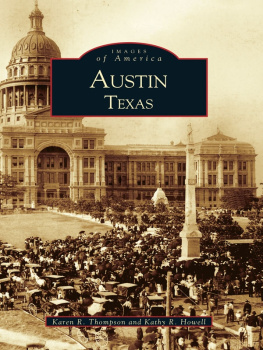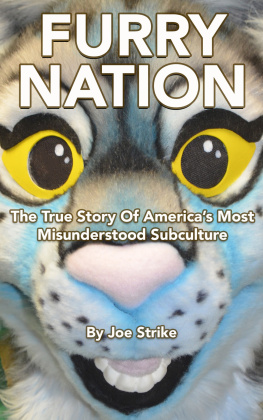To my family and friends, thank you. Due to your immense support, you are off the hook for reading this book.
Furry fandom is a recent phenomenon, but anthropomorphism is an instinct hard-wired into the human mind: the desire to see animals on a more equal footing with people. Its existed since the beginning of time in prehistoric cave paintings, ancient gods and tribal rituals. It lives on today not just in the sports mascots and cartoon characters we see everywhere, but in stage plays, art galleries, serious literature, performance art and among furry fans who bring their make-believe characters to life digitally, on paper, or in the carefully crafted fursuits they wear to become the animals of their imagination.
Strike (2017)
The subject of this book centres on the members of the Furry Fandom, known colloquially as the Furries. There is currently little peer-reviewed research on the Furry Fandom outside of the research group, International Anthropomorphic Research Project (IARP), who have focused much of their research on the fandom. In their work they describe the group, and individuals within it, as the following:
A Furry is a person who identifies with the Furry Fandom culture. Furry Fandom is the collective name given to individuals who have a distinct interest in anthropomorphic animals such as cartoon characters. Many, but not all, Furries strongly identify with, or view themselves as, one (or more) species of animal other than human. Common Furry identities (fursonas) are dragon, feline (cat, lion, tiger), and canine (wolf, fox, domestic dog) species. Some Furries create mixed species such as a folf (fox and wolf) or cabbit (cat and , 198)
It can be difficult to pinpoint a year in which the Furry Fandom started due to the unusual nature of the fandom itself. Unlike other fandoms it is not based on a TV show or a film franchise. Whereas these types of fandoms are easy to historicize as you can pinpoint the start , such as when people watched the TV pilot for instance, there is no singular cultural touchstone for Furries. However, consensus among Furries themselves seems to suggest that the fandom started in the 1980s; despite not being based on any particular base media text. Furries who have been in the fandom since the 1980s often cite an increase in popularity and exposure beginning in the 1990s (Nyareon ).
The internet has helped to facilitate the rapid and mass dissemination of artwork and fiction previous hard copy magazines and fanzines were previously hard to find for those not already within the fandom. Technological advancements resulted in an increase in communication as Furries used internet services such as Skype to communicate with friends if they are unable to attend Fur Meets (, 17). Since the 1990s Furry Fandom membership has continued to grow and now Furry conventions are held in several countries over the course of the year.
In the United States there are multiple conventions dedicated to those who are interested in anthropomorphics. Some of the largest conventions include the Midwest Furfest, which in 2017 hosted 8,771 attendees in Illinois and
As with other fandoms, there have also been several prominent and popular members who have helped shape the fandom into what it is today. In 2008, a Furry Hall of Fame was conceived by MiDFur chairman CynWolfe, and several prominent members of the fandom have since been inducted into it. Patten was inducted in 2011 for his work trying to chronicle the fandom history. Also among the inductees was Uncle Kage, who has chaired Anthrocon since 1999, and the Ranting Gryphon, who is an amateur comedian and performer who commonly makes appearances at Furry conventions. There are also several well-known publishers of Furry material, such as Howl Publications. Howl Publications is run by a Furry by the name of Thurston Howl; in 2015, Howl published an anthology with chapters written by prominent members of the fandom about important aspects of the fandom such as costuming and vernacular.
The description given of the Furries by Gerbasi et al. ( Lauren Faust (who proposed the reboot to Hasbro) attended BronyCon as a guest speaker:
I wanted a respectable show for girls, Faust explains. Saying something is for girls or girly is usually equated with being not worthwhile, being stupid. She wanted to change that, but she never expected shed be so successful. I never dreamed adult men would be into the show, she tells the crowd, because I didnt have any faith that youd give it a try. Now I know better. It gives me the courage to continue. (Wilson )
Christopher , 9; emphasis in original). Bell believes that the Bronies genuinely enjoy the show, rather than using the show as a platform for trolling or for ironic purposes. There is also a similar notion for the Furries interviewed for this book who often feel that they can be childish within the fandom as they are not allowed to do this in the real world. This can be attributed to childishness not conforming to traditional male gender stereotypes.
The IARP regard Furries use of fursonas as a process of self-authentication, using the species of their chosen fursona to personify certain personality traits that the Furry had, or wished to be perceived as having (Gerbasi et al. Therians. Some Furries can be Therian in that they also identify as not wholly human. But not all Furries are Therians as they do consider themselves human, which is why in this book they are considered a separate group. In addition, there are Furries who would be considered as Therians under the definition but would not want to identify as such.
There is some conflict within the Therian subgroup as in what way identification with the animal is socially acceptable. This issue is seen between Therians who believe they can shift into an animal and Therians who identify as not wholly human on a spiritual or psychological level. Some Therian online forums ban posts expressing the belief in p-shifting (physical shifting) from animal to human, for example, in lycanthropy (identity/or similar to Therianthropy are at odds as they believe those who are heavily identified cause the whole group to be stigmatized by the wider society.
The Furry Fandom is overwhelmingly under the age of 25 with the IARP finding that nearly 75 per cent of self-described Furries are under this age (Plante et al. research, however, there was far more concern about inappropriate interactions between older fans and younger ones. There are legitimate concerns as to why interacting with Furries under the age of 18 can cause potential issues (e.g. fandoms can sometimes be concerned about distribution of erotica). Although some fandoms worry about older participants being pushed out. This is uncommon within the Furry Fandom as many older Furries are highly respected. They are often viewed as pioneers within the fandom; it was the older fans who started the conventions that have become popular today. In the glossary provided at the end of this book, grey muzzle is used as an affectionate term for older Furries rather than a derogatory one.
The Furry Fandom has traditionally been overwhelmingly white as well. A poll on AdjectiveSpecies.com has seen the white ethnicity sitting around 89 per cent of all Furries polled for the past seven years., 7). Although intra-fandom racism could be a cause for a dominant white demographic, there are few studies on this within the Furry Fandom context, and so to theorize on this would only be conjecture. Despite this, it is important to recognize research on ethnicity within other fandoms that may be applicable to the Furry Fandom when it comes to future study. In fan studies it is often noted that the default stereotype for a fan, and usually a fan boy, is











